Physical Address
304 North Cardinal St.
Dorchester Center, MA 02124
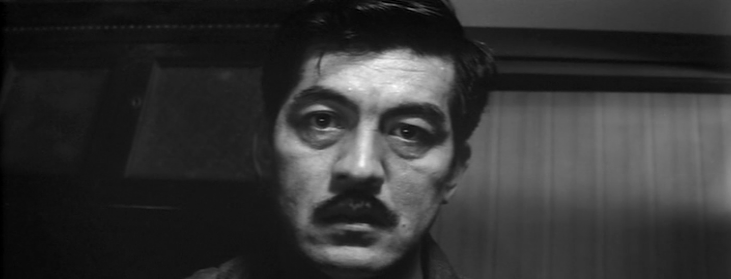
(Continued from Page 4)
As we’ve shown, Uchida throughout his career liked to mix and match genres, but in this regard, A Fugitive from the Past surpasses all his other works. Below are just a few of the cinematic categories into which the movie could conceivably be placed.
The Police Procedural. Of course, this is the genre to which the film most obviously belongs, but, in my view, this aspect of the work is by far the least satisfying. Kurosawa’s High and Low is a police procedural, too, but that director managed to make the details of the manhunt cinematically interesting, whereas in this case, the process of uncovering the truth involves many long, dull speeches in drab rooms. Furthermore, the very concept of the police’s role in this genre – that is, as a force for order within a world constantly threatened by the chaos created by “bad” men – seems to be at odds with Uchida’s vision, which is that of a world of conflict that can only be resolved through explosions of violence (though he clearly doesn’t approve of violence). Evil, in Uchida’s world, can’t be suppressed by law enforcement or other institutions of the State. And in the end, the contradictions embodied in Inukai’s story can only be resolved by self-violence (i.e., suicide), not in a court of law.
The Neorealist Film. As a neorealist work, this film is much more strongly influenced by Kurosawa’s plot-driven late 1940s films, like the aforementioned Drunken Angel and Stray Dog, than by the more famous, and much less tightly-plotted, postwar Italian works that originated the genre, such as Vittorio De Sica’s Bicycle Thieves (Ladri di biciclette, 1948). (Stray Dog in turn was clearly influenced by Uchida’s much earlier Police Officer, as mentioned above.) Because of this, Uchida’s vision of the postwar world must be viewed, as it were, through the latticework of a very dense plot.
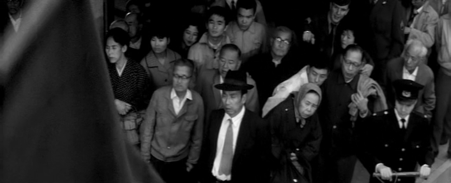
Looking past that plot, though, we can see desperate men pick cigarette butts off the sidewalk and old men and boys shining shoes outside a train station. Yae’s ex-prostitute friend Tokiko, who’s supposed to be relatively well-off, lives in what looks to be a hovel. And the general squalor has naturally spawned political unrest, as seen in the noisy left-wing protest that Yumisaka witnesses during his trip to Tokyo. These shots often approach the aesthetic of the newsreel, yet they don’t, in my opinion, distract from the narrative or from the struggles of Uchida’s characters, but enhance our understanding of both.
The Urban Crime Melodrama. Near the middle of the narrative, during the Tokyo scenes referenced above, the film seems to turn into a yakuza movie, as gangs of young thugs near the bar where Yae works fight for territorial supremacy, with the poor woman caught in the middle. At one point, a patron, one of the gang members, leaves a wad of stolen cash on the bar and departs. Yae, terrified of being caught with the money by the rival gang whose territory this is, tries to give it to her employer, the women who owns the bar, but she, equally afraid, rejects it as if it were unclean. (The expression of terror and disgust on this woman’s face is memorable.)
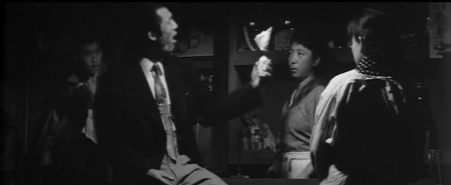
Finally, a tall, menacing, rival gang member, Machida, enters the bar. He reassures both women that he has no intention of harming them. He then asks for an empty jar and, instead of leaving with the money, stuffs the cash in the jar, like a flower in a vase, and returns the jar to the shelf, as a kind of “calling card” – and a warning – to his rivals. These scenes comprise an admirably de-glamorized vision of the postwar criminal underworld.
The Horror Movie. A director in the horror-movie genre could, I believe, sustain a viable career by adapting the innovative audio-visual ideas Uchida introduced in this work. From the opening credits, Tomita Isao’s classic score – perhaps the best of all the fine scores in Uchida’s films – through his use of eerie massed choral voices in both the lowest and highest vocal registers, sets the general tone of unease. And unlike The Mad Fox, in which Expressionistic elements were employed to create an atmosphere of enchantment (though with a disturbing undercurrent) typical of fairy tales, the Expressionistic elements in this film evoke an atmosphere of doom and damnation.
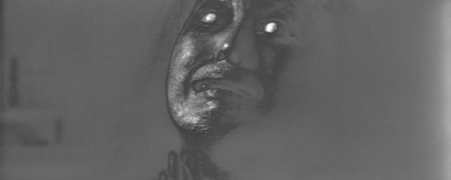
One way Uchida accomplishes this is by the visual technique – the “Toei-W106 Method” (Toei-W106 houshiki) – that Nakanishi, in the above-mentioned article, references.1 This involves a complex combination of three post-production processes: a) the blow-up and trim method, which involves expanding the 16mm image to 35 mm, and then blowing up the resulting image three to five times more; b) the relief method, which puts both negative and positive images into a single positive print; and c) the Sabatier method, which involves deliberately shedding light during the development of the film, causing a flare effect (seen in, for example, the close up of the eyeless face of the itako during the séance in Act One of the film). As Miyao Daisuke remarks in his commentary on the Arrow Blu-ray disk, these techniques “added creative artificiality to the documentary style” of the film as a whole.2
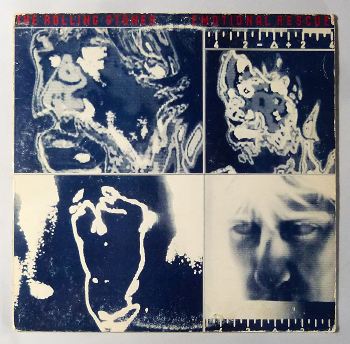
In my review of this work on the World Cinema Paradise website, I compared the visual effect Uchida thus achieves to the thermographic photos of the Rolling Stones that appear on the cover of their album, Emotional Rescue. But the effect in the film is not just one of strangeness, as with that album cover image, but of hell on earth… a hell that can be escaped only through death.
This is Uchida’s greatest film on the theme of karma: his greatest theme. But the nature of karma needs to be clearly grasped if the narrative is to be understood, as the concept is frequently misinterpreted in popular culture. There is nothing mystical about it. To acknowledge its power in human affairs requires no belief in God or even in the supernatural, at least if one rejects the notion that karma can be carried over into future lives through reincarnation. To define it with a folksy American twist, we might say that karma simply means “what goes around, comes around,” through the normal processes of life and human behavior.
But the concept of karma is, in the case of this narrative, deeply complicated by the limits of Inukai’s initial guilt. If his original crime consisted only in refusing to give up a great deal of money that others stole, and if he did this primarily because he assumed, justifiably, that the police would never believe he hadn’t stolen it – and all this is true if one believes his story to the police, which is partly corroborated by the objective depiction of events during the opening scenes of the movie – then the consequences of that crime (namely, several deaths, including Inukai’s own) are, by any fair standard of karmic justice, excessive.
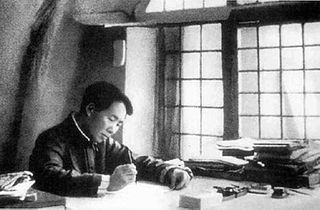
For an explanation, I believe we must fall back upon the “theory of contradiction” that was discussed in our review of Uchida’s comeback movie, A Bloody Spear at Mount Fuji. As described there, Uchida, following the ideas in Mao Tse-tung’s famous essay, “On Contradiction,” believed that logical contradictions build gradually upon one another until a crisis is reached, leading to some kind of explosion (for example, a revolution), which leads in turn to a resolution of all the contradictions.
But in this case, the contradictions are both societal and personal. The primary contradiction is that Inukai’s initial status as a destitute and apparently homeless man, and probably also as a member of the burakumin, had placed him on an equal footing, in the social hierarchy, with the depraved and violent criminals with whom he had been unluckily associating. Thus, his status in the social order has a “multiplier effect” on the relatively minor misdeeds he committed before Yae’s murder.
In the final scene, during the ferry crossing through the Hunger Straits back to Hokkaidō, Yumisaka, after having recited a Buddhist sutra, invites Inukai/Tarumi to cast a bouquet in the direction of Mt. Osorezan (Mount Dread) – which Yae and Inukai had once viewed from her window in Hanaya House in Ōminato – as a symbolic gesture in honor of the dead Yae. Instead, Inukai offers himself… literally, by jumping overboard. Thus in dying, Inukai tries to atone not just for his own sins, but those of an unjust social order. This act, of course, doesn’t change that social order, but it may prompt us, the viewers of this film, at least to question it.
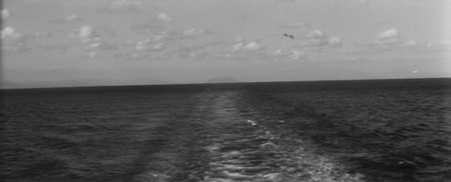
The final shot of this movie – the utterly peaceful sea, viewed straight to the horizon, which has engulfed and absorbed the dead Inukai – seems to me to be one of the most beautiful endings in all Japanese Cinema and perfectly matches the shots of the stormy sea in the film’s opening scene. This sense of peace may be considered, from one point of view, illusory, a temporary state of equilibrium between both meteorological and societal storms. Yet there is an overwhelming sense that some sort of spiritual finality has been achieved.
It should be obvious that I concur with the majority view of Japanese film critics and scholars that A Fugitive from the Past is a masterpiece; indeed, one of the very best of all Japanese movies. However, there are a number of flaws in the film, which become particularly glaring upon repeat viewings, and I believe that an honest evaluation of the film requires that these not be ignored. It may seem perverse to point out these defects, while at the same time championing the filmmaker as a master. But I don’t think any insight into art is to be gained by pretending that artists, even great ones, are gods, rather than the less-than-perfect beings we all are.
These flaws can be divided into four categories: a. poor dubbing, b. logical errors and inconsistencies in the plot, c. pacing issues and d. issues with the characterization of the police.
Poor Dubbing – Most of this film, particularly in the location scenes, is clearly dubbed, and though the dubbing is probably no worse than that in many other Japanese movies of the period, that is hardly a compliment. Joseph Anderson and Donald Richie have pointed out the exceptionally poor quality of much dubbing in Japan, in which little effort seems to be expended in matching an actor’s recorded voice to his or her lip movements.3 Yae’s dialogue in particular is often very badly done: her voice seems nearly disembodied at times.
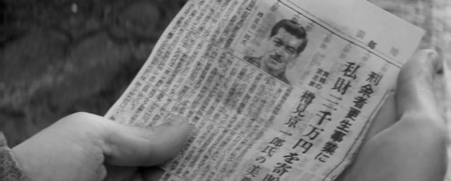
Plot Holes– Perhaps the most serious lapse in logic occurs in the scene in which Yae’s and Takenaka’s bodies are recovered from the sea by the police, and one of the officers retrieves from Yae’s pocket the newspaper clipping reporting on Tarumi’s activities as a philanthropist, which Yae had seen in Tokyo and which had alerted her to his presence in Maizuru. This is hardly an insignificant detail: it’s through this clipping that the police establish the connection between Yae and Tarumi. However, the clipping is not protected by plastic or anything else, and Yae’s body had apparently been submerged in the sea for at least a day. Thus, in real life, the clipping, even in the unlikely event it had not totally disintegrated through water damage, would have been utterly unreadable.
Furthermore, Uchida’s decision to change the cause of Yae’s death from poison (in the novel) to strangulation (see the subsection “Anti-Hero” above) causes him major problems with plot logic at this point in the narrative. When the bodies of Yae and Takenaka are washed up on the beach, Detective Ajimura points out the (obvious) unlikelihood of the two victims having committed double suicide by strangling each other, an observation that evoked giggles in the audience with whom I most recently viewed the film. On the other hand, Tarumi’s ineptitude at covering up his killings through the false “double suicide” motive would not be out of character for him.
As pointed out in the commentary by Prof. Earl Jackson on the Arrow Blu-ray disk, Inukai, after crossing the strait in the boat after killing the convicts, did not need to haul the boat up the mountain and burn it to destroy it as evidence. He could have simply poked holes in the bottom and let it sink, unrecoverable, to the bottom of the sea. In fact, that is probably the first solution that would have occurred to the average person in such an extraordinary situation. Jackson remarks that Inukai’s elaborate destruction of the boat “seems like a symbolic, almost personal mythical gesture.”4 But it doesn’t really make logical sense.
Also, is it likely that the boat’s ashes would have remained for Yumisaka to discover them so much later, on an open hilltop which is, of course, completely exposed to the wind and storms?
Pacing – The main reason that I have called Yoda Yoshikata’s screenplay for Hero of the Red-Light District the best script Uchida ever filmed (see my review) is because that film is a masterpiece of pacing: it’s almost impossible to imagine it being improved by shortening or lengthening it. By contrast, Suzuki Naoyuki’s script for this movie seems to me somewhat less expertly paced. Granted, it would have been impossible to tell this story adequately in a mere two hours. But even conceding the necessity of its unconventional length, some sequences feel attenuated. Particularly, the scenes in which Yae ritualistically fondles the “relics” left behind by Inukai – his money, his fingernail – are repetitious and more than slightly tedious.
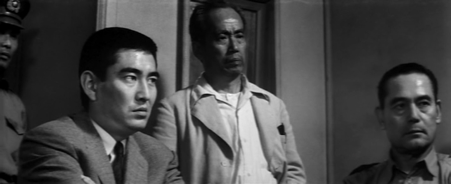
The Police – The characterization of the police in the film is, frankly, one of the biggest stumbling blocks to my unqualified appreciation of it. In recent decades, in American movies and TV shows about cops, writers generally have taken considerable care, using humor and sometimes off-the-wall character quirks, to present them as complex, three-dimensional humans with a life outside the station house or the office. Such an attempt at character depth definitely doesn’t apply here: the cops in this film are totally humorless, grim and obsessed, and thus very hard for the viewer to identify with. Fujita Susumu, an actor familiar for his lively performances in Kurosawa’s movies, who is cast as Maizuru Police Chief Ogimura, literally plays his character as one long, baleful stare. Detective Ajimura, though portrayed by the charismatic young Takakura Ken, is also a one-note character, without shadings of any kind.
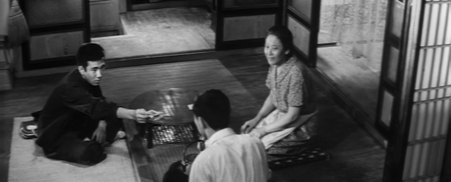
The exception to the dull presentation of the police is the more nuanced character of Yumisaka, who is given by the filmmakers a private life which conflicts with his obsessions as a detective. In the second half of the film, Ajimura has come to Yumisaka’s house as the latter prepares to leave Hokkaidō for Maizuru to join the police investigation of Tarumi. Yumisaka’s wife begs her sons to lend their father money for the trip, but the elder son balks: he is disgusted that his “useless” father had ruined his career because of his obsession with the Inukai case. After Yumisaka has left the house with Ajimura, however, the boy suddenly changes his mind, and gives money to his younger brother so he can run after Yumisaka and pass it on to him.
The point of this episode, which contrasts so strongly with the tone of the rest of the film, seems to be that an overly-idealistic and irresponsible father is still, after all, one’s father, and should be supported when such support is needed. It is a very moving scene. The father of screenwriter Suzuki Naoyuki had been a police officer who eventually became Chief of Police of the city of Takayama in Gifu Prefecture, so it’s not unreasonable to perceive a personal connection in his depiction of two sons’ (reluctant) loyalty to a dedicated policeman father.5 And because Uchida himself had, without having been compelled to do so, abandoned his sons for almost a decade to live and teach in China, I like to think that the scene somehow also mirrored Uchida’s relationship with his sons – or at least Uchida’s view of that relationship.
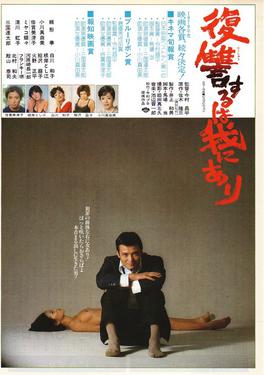
Although they are two distinct works by two very different artists, Imamura Shōhei’s icy 1979 classic, Fukushū suru wa ware ni ari, titled Vengeance Is Mine in the English-speaking world, is very clearly influenced by the Uchida film, which was released fourteen years earlier.6 One might well claim that the creeping sense of national alienation, which Uchida was one of the first Japanese directors to evoke onscreen, reaches an apogee in Imamura’s work, to the point of a kind of nihilism. But though the similarities between the two works are very strong, so are the crucial differences between them, and these may help us better understand Uchida and his achievement.
The Imamura work begins where the Uchida film ends, with the serial killer, Enokizu Iwao, in police custody. (Enokizu, played by the great actor Ogata Ken, was inspired by the career of Nishiguchi Akira, who committed at least five murders in the mid-1960s.) Unlike Uchida’s completely fictional protagonist, who actively seeks death after he’s been caught, Imamura’s semi-fictitious murderer complains that, because his execution is inevitable, he will never live to attain the age of his middle-aged captors, and he regards this fact as a cosmic injustice. So, though the situation is similar, the two characters’ reaction to that situation is totally dissimilar. Inukai is tormented by ineradicable feelings of guilt, while Enokizu is utterly incapable of experiencing that emotion.
The entire remainder of Imamura’s movie consists of a series of flashbacks detailing the crimes of the protagonist. Like Inukai, Enokizu hides his sordid past within an assumed identity: in the case of the latter, that of a university professor, a sensei. Yet Inukai’s postwar identity as a wealthy industrialist is real: he owns an actual business with employees (whom he treats well) and a substantial income, and his philanthropy is also real… and is the inadvertent cause of his destruction. Enokizu, on the other hand, only dresses like a professor: he has no university degree and he has certainly never taught any scholarly subject. He’s a con man with a void behind the image he presents to the world.
Inukai’s killings differ from those of the protagonist of the later movie because his motives are always clear. If one believes Inukai’s story to the police, he killed the two ex-convicts in self-defense; if one doesn’t believe him, he killed the men to acquire the stolen money in order to build a new life for himself. Either way, his motive makes some kind of rational sense. In Vengeance Is Mine, however, the killings become increasingly nonsensical, almost random. And as Enokizu informs a strange old woman who discovers his real identity, although he steals money from his victims, greed isn’t really his motivation. The cash is just his way to keep going, to stay free a bit longer.
Uchida, as noted above, respects detective movie conventions by focusing on the obsessive efforts of the police to catch and jail the criminal, even as he shows these efforts as ultimately inadequate in restoring true order. Imamura, on the other hand, presents the ineptitude of the authorities as a running joke. In one scene, a policeman comes to the door of the inn where Enokizu is staying and drops off a Wanted poster, asking him to display it prominently. The poster, as the viewer can clearly see even without a closeup, depicts Enokizu himself, but the cop can perceive only the outward persona – the respectable sensei – in the man standing in front of him, and he leaves without making an arrest. Enokizu’s picture is literally everywhere: on TV, in newspapers, even (in one memorable scene) in a public service announcement prior to a movie screening that the killer himself attends, yet he evades capture for weeks, and is only caught through a tip by a prostitute who once slept with him. The forces of order, as portrayed here, literally couldn’t be less competent.
The depiction of religion is also almost diametrically opposed in the two films. The dominant faith depicted in A Fugitive from the Past is, of course, Buddhism, which is respected by the characters, though belief doesn’t bring any of them happiness, even Yumisaka. In Vengeance Is Mine, the central religious tradition depicted is Roman Catholicism, as the entire Enokizu family is Catholic. Even Iwao’s unhappy wife, Kazuko, is a Catholic convert.
But Vengeance has to be one of the most anti-Catholic movies I’ve ever seen. The patriarch of the family, Shizuo – played, intriguingly, by Mikuni Rentarō, his performance serving as a kind of bookend with the one he gave in Uchida’s film nearly a decade-and-a-half earlier – is a disreputable old hypocrite, lusting after his daughter-in-law while mouthing religious pieties, and she is no better. Their sinfulness extends even to other species: when a stray dog bites Kazuko, Shizuo is so enraged that he buries the animal up to its neck and allows Kazuko to pour boiling water on its head, killing it. Perhaps Iwao’s only sympathetic trait, or at least the one with which the viewer would most likely identify, is his vitriolic condemnation of his family’s outrageous hypocrisy.
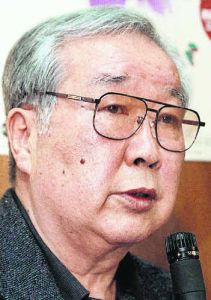
Given the human attributes that Imamura had always championed in his films – spontaneity, acquisitiveness, the survival instinct and, above all, sexuality – it’s hardly a shock that he would take a jaundiced view of a repressive, self-abnegating religion like Catholicism. His early work is practically a gleeful endorsement of the Seven Deadly Sins, particularly Lust and Greed. What is unusual about this work, as Michael Atkinson notes, is a sharp turn towards a kind of sour misanthropy.7 Its keynote is a kind of free-floating disgust and contempt, qualities the filmmaker shares with his protagonist.
Uchida, though, had never looked for salvation in the body and its appetites. He had always sought some transcendent political or religious faith, while never quite being satisfied with any that he ever attempted to embrace.8 In that, more than anything, Inukai’s tragedy is also Uchida’s. And it is the director’s tragic sense (which Imamura generally lacks) that allows him to transcend mere melodrama, while the younger director in my opinion fails to do this. For this reason, A Fugitive from the Past, again in my personal view, is superior as a work of cinema to Vengeance Is Mine, impressive as that work is.
Probably Uchida’s greatest masterpiece, A Fugitive from the Past, despite its flaws, does all the things a classic noir is supposed to do, including eliciting empathy for the “villain,” and does them brilliantly. Given the director’s advanced age at the time (66) and the fact that he’d never done anything quite like this before, it’s his most surprising and impressive achievement.
A Fugitive From The Past (Japan, 1965) – Historical Meaning of ‘Hunger Strait’ (Nakanishi Ryota) – Nakanishi takes a polemically Marxist view of the movie and of film aesthetics in general, and this stance may be off-putting for some readers. However, he provides much very useful information, and many unusual insights into this work and its structure and techniques.
Window on Worlds (Hayley Scanlon)
IFFR (International Film Festival Rotterdam) (2005)
MOMA Uchida Retrospective (2016 series)
Senses of Cinema (Alexander Jacoby) – The film is discussed in the context of Uchida’s entire career
White City Cinema (Michael Glover Smith) – A consideration of this film in the context of the Japanese New Wave
J. B. Spins (Joe Bendel)
High on Films (Arun Kumar)
World Cinema Paradise (John David Baldwin)
[…] Japanonfilm blogger appears to see A Fugitive from the Past, in its focus on social issues, as an outlier among Uchida’s postwar films. I would argue the […]